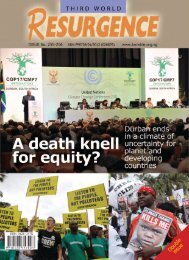Plantations, poverty and power - Critical Information Collective
Plantations, poverty and power - Critical Information Collective
Plantations, poverty and power - Critical Information Collective
Create successful ePaper yourself
Turn your PDF publications into a flip-book with our unique Google optimized e-Paper software.
25<br />
Investment in plantations in the South could be set to increase. In March 2008, more than 100 potential<br />
investors in plantations took part in the “Timberl<strong>and</strong> Investing Latin America Summit” in Sao Paulo,<br />
Brazil. According to a recent survey of US pension funds <strong>and</strong> university endowments, more than US$8<br />
billion is available to be invested worldwide in forest <strong>and</strong> plantation operations. 91<br />
Another type of investment institution investing in plantations are called “Timberl<strong>and</strong>s Real Estate<br />
Investment Trusts (T-REIT)”. These have grown rapidly since 2000. The largest private plantation owner<br />
in the world is a T-REIT called Plum Creek. 92 TIMOs <strong>and</strong> T-REITs tend to invest in plantations rather<br />
than native forests. They have invested in plantations in Oceania, Chile, Brazil, South Africa <strong>and</strong><br />
Uruguay. One US based-fund is establishing plantations in Tanzania.<br />
Another new development in plantations investment is the development of specialist country funds. In<br />
2007, a Colombian plantation investment fund was launched, <strong>and</strong> a Japanese plantation fund may start up<br />
in 2008. 93<br />
Sovereign Wealth Funds (SWFs) are yet another new source of funding which could start investing<br />
heavily in plantations. They certainly have enough money to do so. At the end of 2006, these funds held a<br />
total of US$2.5 trillion. This figure could grow to US$5 trillion by 2010 <strong>and</strong> US$12 trillion by 2015. In<br />
September 2007, a new SWF, China Investment Corporation was launched, with US$200 billion to<br />
invest. 94<br />
So far, these new investment vehicles have had little influence on the way that pulp mills <strong>and</strong> plantations<br />
are established in the South, as the profiles of pulp projects in Section 2 of this report illustrate. Pulp mills<br />
<strong>and</strong> plantations have been established in the South, with more traditional sources of funding – <strong>and</strong> the<br />
help of generous subsidies from public institutions in Europe <strong>and</strong> the North.<br />
Carbon trading<br />
Carbon trading could provide a massive new subsidy for the pulp industry’s expansion in the South.<br />
Companies attempt to claim that the trees they are planting in the South are absorbing carbon from the<br />
atmosphere <strong>and</strong> thus helping to reduce climate change. Awkward facts, such as the impossibility of<br />
predicting what would have happened if the tree plantation had not been established, are brushed aside.<br />
Botnia, for example, is taking advantage of the Clean Development Mechanism (CDM) under the Kyoto<br />
Protocol of the United Nations Convention on Climate Change. The CDM allows companies to offset<br />
their greenhouse gas emissions by buying carbon credits from projects in the global South which are<br />
91 Renata Mercante (2008) “Global investors look for timberl<strong>and</strong> opportunities in Latin America”, RISI blog, 13 March 2008.<br />
http://risiinfo.com/blogs/Global-investors-look-for-timberl<strong>and</strong>-opportunities-in-Latin-America.html<br />
92 Dennis Neilson (2007) “Corporate Private Sector Dimensions in Planted Forest Investments”, Forestry Department Food<br />
<strong>and</strong> Agriculture Organization of the United Nations Planted Forests <strong>and</strong> Trees Working Paper Series, Working Paper<br />
FP/40E, October 2007. http://www.fao.org/forestry/site/10368/en/<br />
93 Dennis Neilson (2007) “Corporate Private Sector Dimensions in Planted Forest Investments”, Forestry Department Food<br />
<strong>and</strong> Agriculture Organization of the United Nations Planted Forests <strong>and</strong> Trees Working Paper Series, Working Paper<br />
FP/40E, October 2007. http://www.fao.org/forestry/site/10368/en/<br />
94 Dennis Neilson (2007) “Corporate Private Sector Dimensions in Planted Forest Investments”, Forestry Department Food<br />
<strong>and</strong> Agriculture Organization of the United Nations Planted Forests <strong>and</strong> Trees Working Paper Series, Working Paper<br />
FP/40E, October 2007. http://www.fao.org/forestry/site/10368/en/















